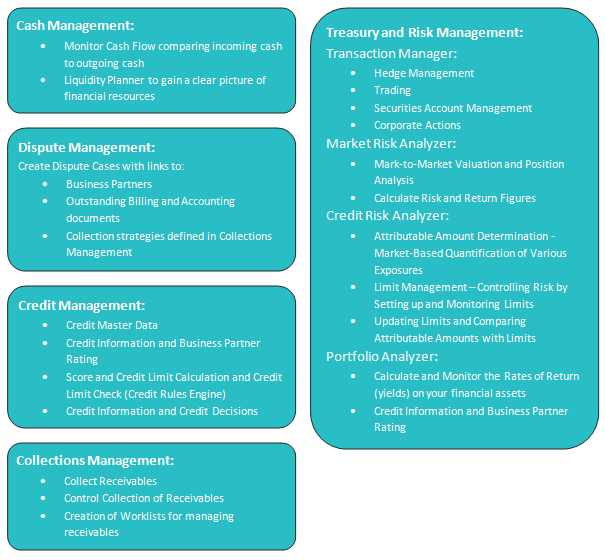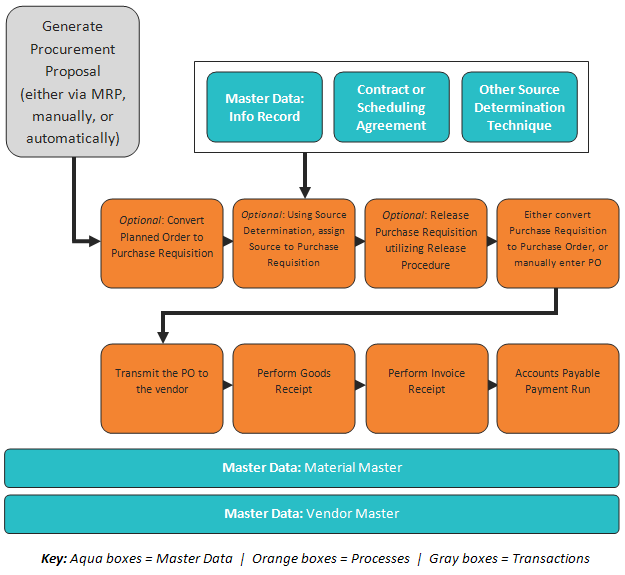
- •Introduction to sap
- •Sap Module Introduction
- •Sap business bydesign
- •Sap business one
- •About sap supplier relationship management software
- •About sap xapps
- •Sap Financial Accounting (sap fi)
- •Financial Accounting includes the following sub-modules:
- •Business process associated with the sap fi module:
- •Sap Financial Supply Chain Management (sap fscm)
- •Business process associated with the sap co module:
- •Subcomponents of the sap Controlling (sap co) Module:
- •Sap Sales and Distribution (sap sd)
- •Order to Cash business process associated with the sap sd module:
- •Subcomponents of the sap Sales and Distribution (sap sd) Module:
- •Sap Logistics Execution (sap le)
- •Sap Production Planning (sap pp)
- •Diagram of the typical Plan to Produce business process associated with the sap pp module:
- •Sap Production Planning (sap pp) is compromised of the following modules:
- •Sap Quality Management (sap qm)
- •The Quality Management (qm) process can integrate with the following sap modules:
- •Sap Plant Maintenance (sap pm)
- •Both Corrective and Preventative maintenance processes exist in the Plant Maintenance module.
- •Subcomponents of the sap Plant Maintenance (sap pm) Module:
- •Sap Project System (sap ps)
- •Common processes in Project System include:
- •Sap Human Resources (sap hr)
- •Sap Human Resources (hr) Components or Sub-Components:
- •Typical Hire to Retire business process associated with the sap hr module:
Sap Financial Supply Chain Management (sap fscm)
The Financial Supply Chain Management module (SAP FSCM) includes the following information and processes:
Credit Management
Cash and Liquidity Management
Collections Management
Dispute Management
Treasury and Risk Management
FSCM provides the ability to have a better view of your corporate cash flow, manage disputes with your customers, and add efficiency to your billing processes. Below, you will find a diagram of the sub-components of FSCM and their key features.

This is brief review of the components and processes associated with the SAP FSCM module. For a more in-depth understanding of the Financial Supply Chain Management module, please review our available SAP Financial Supply Chain Management training.
Please Note: The Learn SAP pages on this site are intended to be brief summaries for SAP customers who are encountering SAP for the first time. For more advanced knowledge, please review the articles in our SAP Library, and our SAP Trainingofferings for both Super Users and Project Teams.
he purpose of the Controlling (CO) module in SAP is to provide organizations with a method of slicing and dicing data to view costs from an internal management perspective and provide a view of profitability beyond that of basic financial reporting. This allows the organization to create information in a manner that is tailored to their specific business measurements needs. Controlling allows an organization to:
Plan and track overhead costs within the company's specific organizational structure.
Track costs related to specific projects or events and either capitalize those costs or charge them to appropriate departments upon completion.
Perform "Activity Based Costing".
Perform Product Costing, measuring production cost and variances.
Report profitability by product line, division, or other internal measurement.
Report sales and gross profitability by external measures such as market segments or customer groups.
Controlling consists of all master data, configuration, and reporting required to analyze both spend and revenues, both within and across organizations. This includes the following master data:
Cost Elements - cost and/or revenue accounts
Cost Centers - departmental units
Profit Centers - business lines, product lines or divisions
Internal Orders - projects or events
Functional Area - Cost of Sales Accounting
Statistical Key Figures - non financial statistics for allocating or measuring financial costs
Activity Types - Labor or other activity costs
Business process associated with the sap co module:

Subcomponents of the sap Controlling (sap co) Module:
CO-OM - Overhead Management - CO-OM-CCA - Cost Center Accounting - CO-OM-OPA - Internal Order Accounting - CO-OM-CEL - Cost Element Accounting - CO-OM-ABC - Activity Based Costing
CO-PCA - Profit Center Accounting
CO-PA - Profitability Analysis
CO-PC - Product Costing
This is brief review of the components and processes associated with the SAP CO module. For a more in-depth understanding of the Controlling module, please review our available SAP Controlling training.
Please Note: The Learn SAP pages on this site are intended to be brief summaries for SAP customers who are encountering SAP for the first time. For more advanced knowledge, please review the articles in our SAP Library, and our SAP Trainingofferings for both Super Users and Project Teams.
SAP Materials Management (SAP MM)
The Materials Management module (SAP MM) consists of all master data, system configuration, and transactions to complete the Procure to Pay process. This process map spans from MRP generated procurement proposals through final invoice receipt and verification.
SAP Materials Management Components or Sub-Components:
Vendor Master and Material Master data
Consumption Based Planning
Purchasing
Inventory Management
Evaluation of Materials
Invoice Verification
Procure to Pay business process associated with the SAP MM module:

Subcomponents of the SAP Materials Management (SAP MM) Module:
Purchasing
Inventory Management
Logistics Invoice Verification
Physical Inventory
Material Valuation
Material Requirements Planning (MRP)
External Services Management
This is brief review of the components and processes associated with the SAP MM module. For a more in-depth understanding of the Materials Management module, please review our available SAP Materials Management training.
Please Note: The Learn SAP pages on this site are intended to be brief summaries for SAP customers who are encountering SAP for the first time. For more advanced knowledge, please review the articles in our SAP Library, and our SAP Trainingofferings for both Super Users and Project Teams.
